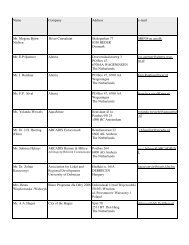HOW TO USE FLOODPLAINS FOR FLOOD RISK ... - SGGW
HOW TO USE FLOODPLAINS FOR FLOOD RISK ... - SGGW
HOW TO USE FLOODPLAINS FOR FLOOD RISK ... - SGGW
You also want an ePaper? Increase the reach of your titles
YUMPU automatically turns print PDFs into web optimized ePapers that Google loves.
discharge, increased sediment load and altered patterns<br />
of erosion and sedimentation (Gregory et al.,<br />
1987; Starkel et al., 1991). Subsequent intensification<br />
of direct channel works was, in part, a response to the<br />
changes in channel morphology resulting from this<br />
deforestation (Leach and Leach, 1982). Initially these<br />
works were primitive, mainly for the provision of local<br />
water power and flows. Subsequently, larger scale<br />
changes occurred to improve the navigability of rivers,<br />
prevent flooding and reclaim floodplains, largely in<br />
response to a developing commercial environment<br />
(Darby, 1983). The 19 th century saw a boom in river<br />
26<br />
PART II – Background<br />
regulation activities, driven by three main factors; a<br />
need to create more agricultural land to provide food<br />
for rapidly growing urban populations, a need to control<br />
the breeding grounds of malaria-carrying mosquitoes<br />
and a desire to control increased flooding. Already<br />
by the end of the 18 th century dam building<br />
technology was well established, but the peak period<br />
of construction was 1950-1980 (Petts, 1989). The end<br />
of this period coincides with the realisation that environmental<br />
damage was resulting from these activities,<br />
and today there is a perceived need to return rivers<br />
and floodplains to a more natural, sustainable state.




